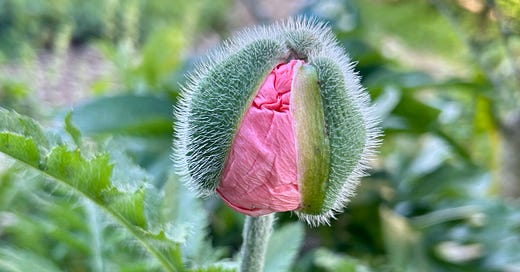Tending & Regrowing
When we bought our home almost seven years ago, the garden was a barren, herbicidal desert. It invited me to bring it back to life.
To see takes time. Like to have a friend takes time.
—Georgia O’Keefe
When we moved into our house in 2018, the yard here was little more than chemically treated lawn and a few punished shrubs. The borders of the walled back garden were covered in thick layers of rock and there were no plants to speak of. Legend has it from our neighbor that she’d only narrowly convinced the former owners here not to dress the entire 6500 square feet of the yard in astro turf. But even minus this atrocity, the vibe of the yard on our arrival here was grim, lifeless … herbicidal.
Still, some strain of life sang up from the compacted ground here when we first saw the place, and rested its hand on me. The grim yard wasn’t a reason to pass over the house, but reason to choose it. So that the grounds might be rematriated. So that I might endeavor to give one small corner of NE Portland back to the flora, the fauna, and Gods of place. This is what I’ve tried to do.
Our first year project here was on the inside of the house. “Temple building,” we cheekily but sincerely called it as Seth and I knocked through walls and tore up floors, as he commando-crawled through the attic to feed electricity to new parts of the house and I skim-coated every one of the bumpy walls smooth. We camped with our cheerfully game daughter in the basement and made our meals on a single burner hot plate in the laundry room for about 5 months. Holy months of improvising. During this time, the garden waited patiently for me.
And then the house was in decent enough shape that it was time to get outside. I’ll confess here that a normal person would have hired out a good portion of what I was about to get into. But there was something necessary about having my hands in every part of the work, hateful though some of it was. For example, running the full length of the back garden wall (100 feet roughly) there was a lifeless border of rock about 3 feet deep and 6 inches thick. Under the countless shovels full of rock, there was a thick plastic barrier of weed cloth. I pulled the 100 ft of it up with great effort, only to find another layer of rock underneath it, a second layer of weed cloth underneath that. Beneath this, I found yet another layer of dirt and stones and another layer of plastic!!! Three layers. I bathed that weed cloth in my foulest curses as I dragged it to the bin. I sang gentle songs of return to the emerging soil.
That first phase was long, arduous, with little visible reward on the front end. Weekend after weekend I entered the garden in the morning and came inside in the evening, my skin, fingernails, hair, inside of my nostrils, and every fiber of my clothing permeated with dirt. Still I was glad for it, such was the patience required and the courtship at work. I was learning how to listen to this place as I carefully undressed the strangled soil, yanked up the sod, amended the ground with compost and mulch, and began mostly native planting. In turn, the place was offering itself up to me, taking shape initially through my handiwork, and over time, through its own magnificent effulgence.
Patience has given me so much in this place. It takes time for a tree to fruit, and to grow tall enough to create a habitat for shade loving plants, or a red-breasted nuthatch. It takes time for a magnolia tree to flower out in its full radiance, perfuming the entire back garden. There is more personality in this space with every passing season, and life builds on itself here. The initial toll required in sweat and blisters has given way to much less hungry work. Many of the plants manage their own proliferation now, re-seeding, mulching with their own leaf fall. And now there is a different kind of attunement asked of me as my tending role becomes more passive. To listen to how these perfect forest-modeled systems function in a harmony that longs to inform everything I do.
At last count I’ve planted 39 trees, about a third of them fruiting, and as many shrubs. Loads of berries, over 20 kinds of medicinal plant or herb. There are over 40 different varieties of native plant or tree here. 8 compact car sized piles of wood chip mulch have been distributed through the garden, and as many cubic yards of compost. The vegetable garden on the south facing side of the yard is a cross hatch of raised and in the ground beds that are now a mix of cover crops and overwintered delights. Kales, swiss chard, radicchio, chicories. The fauva beans are flowering out now, silky black pupils shining out from the white sclera of their petals.
Here is a kinship worthy of my tending.





